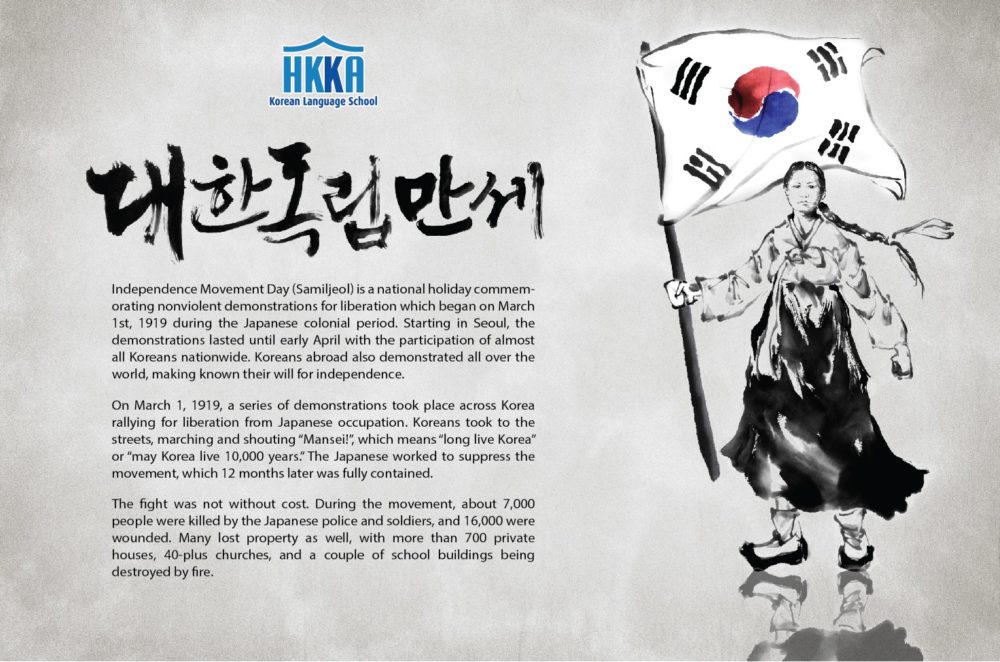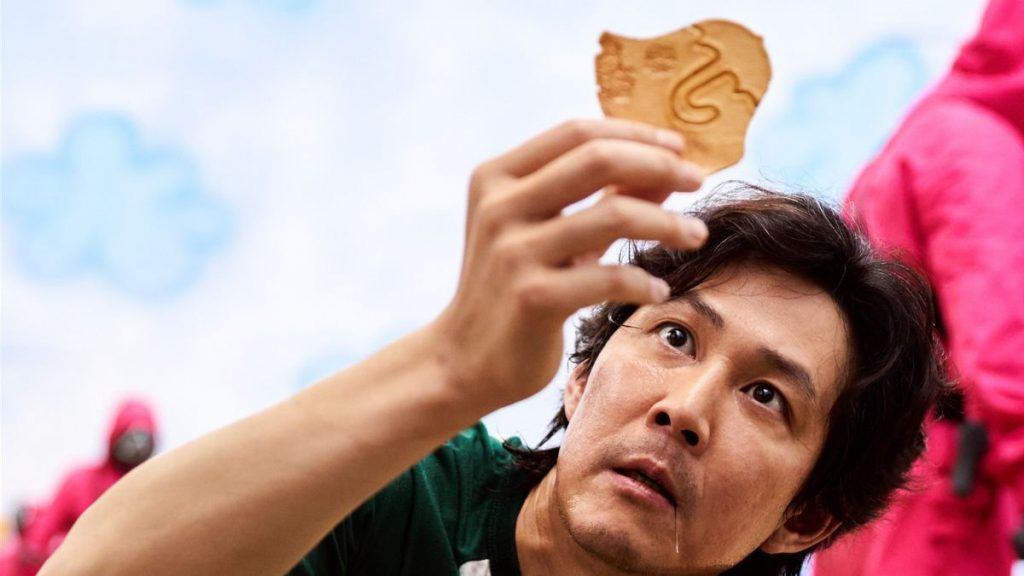Commemorating the 102nd Anniversary of the March 1st Movement!
This year marks the 102nd anniversary of the March 1st (Independence) Movement, known as “Samil-jeol” (삼일절) in Korean (which literally means “Three-One Movement”) as well as the establishment of Korea’s provisional government in 1919 during the Japanese occupation.
Please take a few minutes to read an excerpt from Wikipedia regarding this historic day for Koreans. You can find the original here. (Image credit: HKKA Korean Language School.)
March 1st Movement
The March 1st Movement was one of the earliest public displays of Korean resistance during the rule of Korea by Japan from 1910 to 1919.
Background
The Samil Movement arose in reaction to the repressive nature of colonial occupation under the de facto military rule of the Japanese Empire following 1905, and inspired by the “Fourteen Points” outlining the right of national “self-determination“, which was proclaimed by President Woodrow Wilson at the Paris Peace Conference in January 1919. After hearing news of Wilson’s speech, Korean students studying in Tokyo published a statement demanding freedom from colonial rule.[1]
Former Emperor Gojong died on January 21, 1919. There was widespread suspicion that he had been poisoned, credible since previous attempts (the “coffee plot”) were well-known, and other leaders had been assassinated by Japanese agents.[2]
Events in Korea
At 2 p.m. on March 1, 1919, 33 activists who formed the core of the Samil Movement convened at Taehwagwan Restaurant in Seoul; they read out loud the Korean Declaration of Independence, which had been drawn up by historian Choe Nam-seon. The activists initially planned to assemble at Tapgol Park in downtown Seoul, but chose a more private location out of fear that the gathering might turn into a riot. The leaders of the movement signed the document and sent a copy to the Governor General.
We herewith proclaim the independence of Korea and the liberty of the Korean people. This we proclaim to all the nations of the world in witness of human equality. This we proclaim to our descendants so that they may enjoy in perpetuity their inherent right to nationhood.
In as much as this proclamation originates from our five-thousand-year history, in as much as it springs from the loyalty of twenty million people, in as much as it affirms our yearning for the advancement of everlasting liberty, in as much as it expresses our desire to take part in the global reform rooted in human conscience, it is the solemn will of heaven, the great tide of our age, and a just act necessary for the co-existence of all humankind. Therefore, no power in this world can obstruct or suppress it!
The movement leaders telephoned the central police station to inform them of their actions and were publicly arrested afterwards.
Before the formal declaration, Korea also published and broadcast the following complaints, in order to be heard by the Japanese people through papers and media:
- Discrimination by the government when employing Koreans versus Japanese people; they claimed that no Koreans held important positions in the government.
- A disparity in the quality of education being offered to Korean and Japanese people.
- Mistreatment and open disregard of Koreans by the Japanese occupiers.
- Political officials, both Korean and Japanese, were arrogant.
- No special treatment for the Korean upper class or scholars.
- The administrative processes were too complicated and new laws were passed too frequently for the general public to follow.
- Too much forced labor that was not desired by the public.
- Taxes were too heavy and the Korean people were paying more than before, while getting the same amount of services.
- Land continued to be confiscated by the Japanese people for personal reasons.
- Korean village teachers were being forced out of their jobs because the Japanese were trying to suppress Korean culture and teachings.
- Korea’s resources and labor had been exploited for the benefit for the Japanese. They argued that while Koreans were working towards development, they did not reap the benefits of their own work.
- These grievances were highly influenced by Wilson’s declaration of the principle of self determination as outlined in his “Fourteen Points” speech.[3]
Massive crowds assembled in Pagoda Park to hear a student, Chung Jae-yong, read the declaration publicly. Afterwards, the gathering formed into a peaceable procession, which the Japanese military police attempted to suppress. Special delegates associated with the movement also read copies of the independence proclamation from appointed places throughout the country at 2 p.m. on that same day.
As the processions continued to grow, the Japanese local and military police could not control the crowds. The panicked Japanese officials called in military forces to quell the crowds, including the naval forces. As the public protests continued to grow, the suppression turned to violence, resulting in Japanese massacres of Koreans and other atrocities.
Approximately 2,000,000 Koreans had participated in the more than 1,500 demonstrations. Several thousand were massacred by the Japanese police force and army.[4] The frequently cited The Bloody History of the Korean Independence Movement (Hangul: 한국독립운동지혈사; Hanja: 韓國獨立運動之血史) by Park Eun-sik reported 7,509 people killed, 15,849 wounded, and 46,303 arrested. From March 1 to April 11, Japanese officials reported 553 people killed, and more than 12,000 arrested. They said that 8 policemen and military were killed, and 158 wounded. As punishment, some of the arrested demonstrators were executed in public.[5]
In 1920, the Battle of Cheongsanri broke out in Manchuria between exiled Korean independence fighters and the Japanese Army.
Effects
The March 1st Movement provided a catalyst for the Korean Independence Movement. Given the ensuing suppression and hunting down of activists by the Japanese, many Korean leaders went into exile in Manchuria, Shanghai and other parts of China, where they continued their activities. The Movement was a catalyst for the establishment of the Provisional Government of the Republic of Korea in Shanghai in April 1919. It also influenced the growth of nonviolent resistance in India and many other countries.[6] The Korean Liberation Army was subsequently formed and allowed to operate in China by the Nationalist Government of China. During this period, there was a mobilization of Catholic and Protestant activists in Korea, with activism encouraged among the diaspora in the U.S., China and Russia.
The Japanese government reacted to the March 1st Movement by heightening its suppression of dissent and dismissing the Movement as the “Chosun Manse Violent Public Disorder Incident” (조선 공공 만세 폭력 사건). Governor-General Hasegawa Yoshimichi accepted responsibility for the loss of control (although most of the repressive measures leading to the uprising had been put into place by his predecessors); he was replaced by Saito Makoto. The military police were replaced by a civilian force. Limited press freedom was permitted under what was termed the ‘cultural policy’. Many of these lenient policies were reversed during the Second Sino-Japanese War and World War II.
On May 24, 1949, South Korea designated March 1st as a national holiday. General Choe Hong-hui dedicated the first of the three patterns (삼일 틀 – Sam-il teul) trained by III-degree black belts of taekwon-doto the Sam-il Movement.
International reaction
United States and Korea
President Woodrow Wilson issued his Fourteen Points in January 1918. The points included… in terms of US relations with Korea, “a free, open-minded, and absolutely impartial adjustment of all colonial claims.”[7]
However, as manifested at the Paris Peace Conference of 1919, Wilson was not interested in challenging global power relations. Since Japan was one of the victors and Korea was its colony, a discussion of the status of Korea was not undertaken.[7]
In April 1919, the US State Department told the ambassador to Japan that “the consulate [in Seoul] should be extremely careful not to encourage any belief that the United States will assist the Korean nationalists in carrying out their plans and that it should not do anything which may cause Japanese authorities to suspect [the] American Government sympathizes with the Korean nationalist movement.”[8]
Delegation
Japan violently suppressed the March First Movement. The United States remained silent.[7] Despite this, the Korean National Association planned a three-man delegation in the United States to attend the Paris Peace Conference and attempt to represent Korea’s interests. Dr. Rhee (representing Hawai’i), Rev. Chan Ho Min (representing the West Coast) and Dr. Henry Han Kyung Chung (representing the Midwest) were selected, but they were unable to attend. They encountered visa problems and feared that the delegates may not be allowed to reenter the United States.[9]
A delegation of overseas Koreans, from Japan, China, and Hawai’i, did make it to Paris. Included in this delegation, was Kim Kyu-sik (김규식), a representative from the Korean Provisional Government in Shanghai.[7] After considerable effort, he managed to arrange passage with members of the Chinese delegation to the peace conference. He traveled on a Chinese passport and under a Chinese name in order to evade the Japanese police. The Chinese were eager for the opportunity to embarrass Japan at the international forum, and several top Chinese leaders at the time, including Sun Yat-sen, told U.S. diplomats that the peace conference should take up the question of Korean independence. Beyond that, however, the Chinese, locked in a struggle themselves against the Japanese, could do little for Korea.[10]
The United States did not pay any substantial attention to these individuals, and the delegation was blocked from official participation as Korea was classified as a Japanese colony.[11]
The failure of the Korean nationalists to gain support from the Paris Peace Conference ended the possibility of foreign support.[12]


[…] Commemorating the 102nd Anniversary of the March 1st Movement! […]